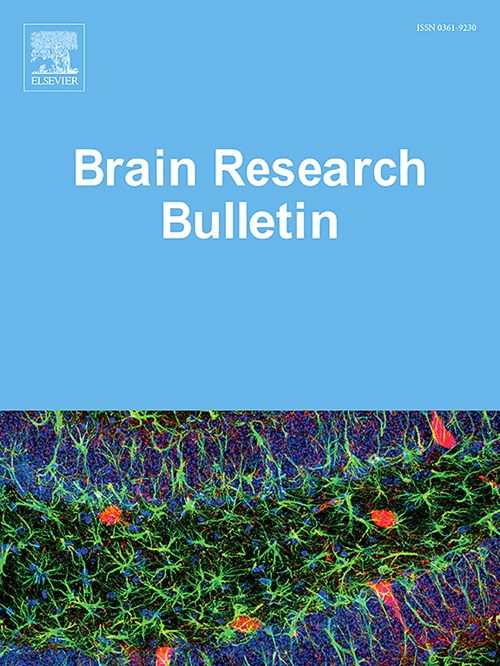Activation of cannabinoid CB1 receptors suppresses HCN channels function in dorsal root ganglion neurons of rats
IF 3.5
3区 医学
Q2 NEUROSCIENCES
引用次数: 0
Abstract
Cannabinoid receptor (CBR) and hyperpolarization-activated cyclic nucleotide-gated (HCN) channels are both critically involved in pain hypersensitivity induced by nerve injury. Both CBR and HCN channels are expressed in sensory neurons of the dorsal root ganglia (DRG). Studies have shown that HCN channel function is regulated by cAMP-PKA signaling, and the activation of cannabinoid receptor 1 (CB1R) can inhibit cAMP-PKA activity. However, it remains unclear whether the function of HCN channels is regulated by CB1R activity in DRG. In this study, we investigated the effect of ACEA, a selective agonist for CB1R, on HCN channel expression and function in the DRG of rats with chronic constriction injury (CCI) of the sciatic nerve. Mechanical allodynia was assessed by measuring the mechanical withdrawal threshold (MWT). HCN1/ HCN2 channel expression and cAMP level in lumbar 4, 5 and 6 (L4–6) DRG were detected by Western blot analysis and ELISA, respectively. As a result, MWT decreased significantly in CCI rats. HCN1/ HCN2 channel expression and cAMP level increased in the ipsilateral L4–6 DRG after CCI operation. Notably, intrathecal injection of ACEA (0.05 mg/kg) significantly decreased mechanical allodynia, HCN1/ HCN2 expression, and cAMP level in CCI rats, and this effect was blocked by the CB1R antagonist AM251. On the other hand, Ih mediated by HCN channels of DRG neurons was recorded by whole-cell patch-clamp to evaluate HCN channel activity. In this assay, ACEA (1 μM) significantly reduced the amplitude of Ih in DRG neurons (P < 0.01), while pretreatment with AM251 blocked the inhibitory effect of ACEA on Ih (P < 0.01). In addition, 8-Br-cAMP, a PKA activator, could reverse the effect of ACEA on Ih in DRG neurons (P < 0.01), indicating that CB1R activation suppresses the function of HCN channels by decreasing cAMP-PKA activity. In conclusion, these findings suggest that CB1R activation can inhibit the function of HCN channels by decreasing cAMP-PKA activity, resulting in decreased excitability of primary sensory neurons.
大麻素CB1受体激活抑制大鼠背根神经节神经元HCN通道功能
大麻素受体(CBR)和超极化激活的环核苷酸门控(HCN)通道都在神经损伤引起的疼痛超敏反应中起重要作用。CBR和HCN通道均在背根神经节(DRG)感觉神经元中表达。研究表明,HCN通道功能受cAMP-PKA信号的调控,大麻素受体1 (cannabinoid receptor 1, CB1R)的激活可抑制cAMP-PKA活性。然而,目前尚不清楚DRG中HCN通道的功能是否受CB1R活性的调节。本研究探讨了CB1R选择性激动剂ACEA对坐骨神经慢性收缩损伤大鼠DRG中HCN通道表达和功能的影响。通过测量机械戒断阈值(MWT)评估机械异常性痛。Western blot和ELISA分别检测腰4、5、6 (L4-6) DRG中HCN1/ HCN2通道表达和cAMP水平。结果,CCI大鼠的MWT明显降低。CCI术后同侧L4-6 DRG中HCN1/ HCN2通道表达及cAMP水平升高。值得注意的是,鞘内注射ACEA(0.05 mg/kg)可显著降低CCI大鼠的机械异常性痛、HCN1/ HCN2表达和cAMP水平,而这种作用被CB1R拮抗剂AM251阻断。另一方面,采用全细胞膜片钳法记录DRG神经元HCN通道介导的Ih,评价HCN通道活性。在本实验中,ACEA(1 μM)显著降低了DRG神经元Ih的振幅(P <; 0.01),而AM251预处理阻断了ACEA对Ih的抑制作用(P <; 0.01)。此外,PKA激活剂8-Br-cAMP可以逆转ACEA对DRG神经元Ih的影响(P <; 0.01),表明CB1R激活通过降低cAMP-PKA活性来抑制HCN通道的功能。综上所述,CB1R激活可通过降低cAMP-PKA活性抑制HCN通道功能,导致初级感觉神经元兴奋性降低。
本文章由计算机程序翻译,如有差异,请以英文原文为准。
求助全文
约1分钟内获得全文
求助全文
来源期刊

Brain Research Bulletin
医学-神经科学
CiteScore
6.90
自引率
2.60%
发文量
253
审稿时长
67 days
期刊介绍:
The Brain Research Bulletin (BRB) aims to publish novel work that advances our knowledge of molecular and cellular mechanisms that underlie neural network properties associated with behavior, cognition and other brain functions during neurodevelopment and in the adult. Although clinical research is out of the Journal''s scope, the BRB also aims to publish translation research that provides insight into biological mechanisms and processes associated with neurodegeneration mechanisms, neurological diseases and neuropsychiatric disorders. The Journal is especially interested in research using novel methodologies, such as optogenetics, multielectrode array recordings and life imaging in wild-type and genetically-modified animal models, with the goal to advance our understanding of how neurons, glia and networks function in vivo.
 求助内容:
求助内容: 应助结果提醒方式:
应助结果提醒方式:


